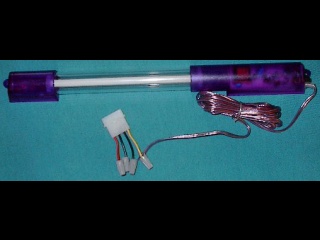Product: Glow 10″ purple neon light rod
Product Link: Purchased at Target
MFR Link: N/A
Reviewer: Jim Adkins
Date: 10/22/2001

Standard disclaimer here: I can accept no responsibility for any mishap that arises from this article. If you are not comfortable replacing a pigtail, find someone to help you who is. Always take precautions when working with electricity. A while back, I wrote a DIY article on installing an acrylic side panel. I still have that panel, and I have grown attached to it. What better way to show off all my hard work, blue motherboard, blue video card, blue rounded cables, big polished copper heat sink? All I needed now was a neon light.
I started to look for a neon light. What better way to show off my tricked-out rig? What I discovered was much the same as when I wrote the article about acrylic side panels. The neon lighting kits were not cheap. Commonly ranging from thirty to forty dollars, throw in ten or fifteen bucks for shipping, and things are quickly becoming expensive. So I started wondering why I couldn’t put together one of my own? Not only would it save me some money, but also, equally important, it would give me an excuse to tinker around some.
Warning: If you are under thirty years old, you may want to skip the next paragraph. As when I was a teenager, this old fogey drivel made me want to puke.
You see, on the weekends, when I was a child, while other kids were playing baseball and camping, my father used to take me along to Radio Shack or PI Burkes. With a five-gallon bucket of old vacuum tubes that he had pulled out of an old TV or other electronics, he was working on, and let me test them. At the same time, he talked shop to the technician behind the counter and shared a White Castle Coffee. It seems White Castle coffee was what the high-brow intellectuals drank before there was Starbucks.
The first place I went to look for a neon light was Pep Boys. No luck there. They had a 10-inch neon tube similar to what I was looking for, but it cost thirty dollars. So I kept looking. I finally found what I was looking for at Target in the automotive section. It was less than twenty dollars. It was designed to run on a twelve-volt power supply (the end was made to plug into a cigarette lighter receptacle). I figured it wouldn’t be too hard to mod it to work in a computer case since its power supply also supplies twelve volts.
I took it out and plugged it into the cigarette lighter to see if it worked when I got it home. It worked fine. It also has a sound-activated setting, a fascinating effect that mimics a strobe light with the added bonus of flashing in time with the music. I later learned that this is really cool when playing an fps at night, but I’m getting ahead of myself there.
After seeing that it worked, I was curious about how much heat it put out, so I let it run for about fifteen minutes. It was still cool to the touch. So cool, in fact, that I didn’t see the need to get out my temperature probe and take an official measurement, but it wasn’t more than 1 to 2 deg c above ambient temperature. As for the light output from this neon tube, while I wouldn’t want to read by it, it is pretty bright–far brighter, in fact, than the nightlight we keep on in the bathroom at night. You can see the glow through every crack and crevice in the case.
At this point, you need to put on a new pigtail (the end that plugs into the power supply). Since the one that plugs into the cigarette lighter is obviously not going to work in your computer case. This means finding a three to four-pin fan header converter and lopping off the two wires for the three-pin header. Then cutting off the wires on the other end so it matches the photo below. If there are two ends to your converter, you want to preserve the end that would plug into a hard drive. Again see the picture below.

